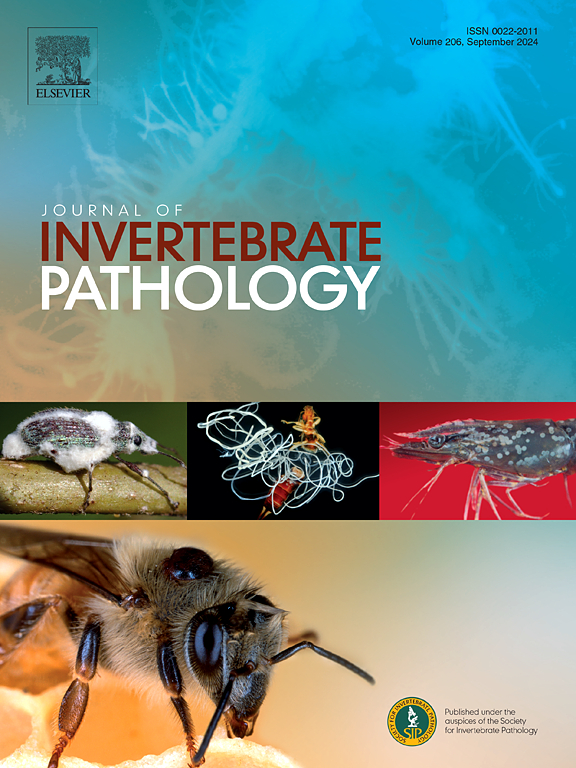体外候选物的靶向敲除不会改变体内沃尔巴克氏体密度
IF 2.4
3区 生物学
Q1 ZOOLOGY
引用次数: 0
摘要
细菌内共生沃尔巴克氏体已成为一种有效的生物防治方法,以减少虫媒病毒的传播。将沃尔巴克氏体从黑腹果蝇转感染埃及伊蚊,可导致沃尔巴克氏体诱导的重要表型转移,包括生殖修饰、细胞质不相容以及对登革热和基孔肯雅热等病毒的抑制。然而,这些关键特征以及其他沃尔巴克氏体与宿主相互作用的机制仍未完全了解。最近,对wMel感染的果蝇S2细胞进行了体外全基因组RNAi筛选,发现了大量宿主基因,这些基因在靶向时改变了wMel密度。如果这些发现可以在体内复制,这将为系统地和以组织特异性的方式调节wMel密度提供一个强大的工具,从而可以询问wMel与宿主的相互作用。在这里,我们使用GAL4/UAS系统表达RNAi分子,靶向宿主基因候选基因,之前在体外鉴定出失调的wMel密度。我们发现,系统敲除两个候选黑腹龙基因不会导致wMel密度失调。为了探索我们的研究与先前工作之间的一致性,我们还研究了黑腹龙体内wMel的本地组织特异性密度。我们表明密度在组织之间是不同的,并发现单个组织密度不是其他组织密度的可靠线性预测因子。我们的结果证明了在系统应用中实施体外研究结果的复杂性。本文章由计算机程序翻译,如有差异,请以英文原文为准。

Targeted knockdown of in vitro candidates does not alter Wolbachia density in vivo
The bacterial endosymbiont Wolbachia has emerged as an effective biocontrol method to reduce arbovirus transmission. Transinfection of wMel Wolbachia from Drosophila melanogaster to Aedes aegypti results in the transfer of important Wolbachia-induced phenotypes including the reproductive modification, cytoplasmic incompatibility, and inhibition of viruses including dengue and chikungunya. However, the mechanisms underlying these critical traits as well other Wolbachia-host interactions are still not fully understood. Recently an in vitro genome wide RNAi screen was performed on wMel-infected Drosophila S2 cells and identified large cohorts of host genes that alter wMel density when targeted. If these findings can be replicated in vivo, this would provide a powerful tool for modulating wMel density both systemically and in a tissue-specific manner allowing for interrogation of wMel-host interactions. Here, we used the GAL4/UAS system to express RNAi molecules targeting host gene candidates previously identified to dysregulate wMel density in vitro. We found systemic knockdown of two candidate D. melanogaster genes does not lead to wMel density dysregulation. To explore the lack of consistency between our study and previous work, we also examined native tissue-specific density of wMel in D. melanogaster. We show density is varied between tissues and find that individual tissue densities are not reliable linear predictors of other tissue densities. Our results demonstrate the complexities of implementing in vitro findings in systemic applications.
求助全文
通过发布文献求助,成功后即可免费获取论文全文。
去求助
来源期刊
CiteScore
6.10
自引率
5.90%
发文量
94
审稿时长
1 months
期刊介绍:
The Journal of Invertebrate Pathology presents original research articles and notes on the induction and pathogenesis of diseases of invertebrates, including the suppression of diseases in beneficial species, and the use of diseases in controlling undesirable species. In addition, the journal publishes the results of physiological, morphological, genetic, immunological and ecological studies as related to the etiologic agents of diseases of invertebrates.
The Journal of Invertebrate Pathology is the adopted journal of the Society for Invertebrate Pathology, and is available to SIP members at a special reduced price.

 求助内容:
求助内容: 应助结果提醒方式:
应助结果提醒方式:


